最新PEP人教版小学英语六年级下册Unit 3 Part A Let's learn.说课稿
- 格式:doc
- 大小:28.00 KB
- 文档页数:4
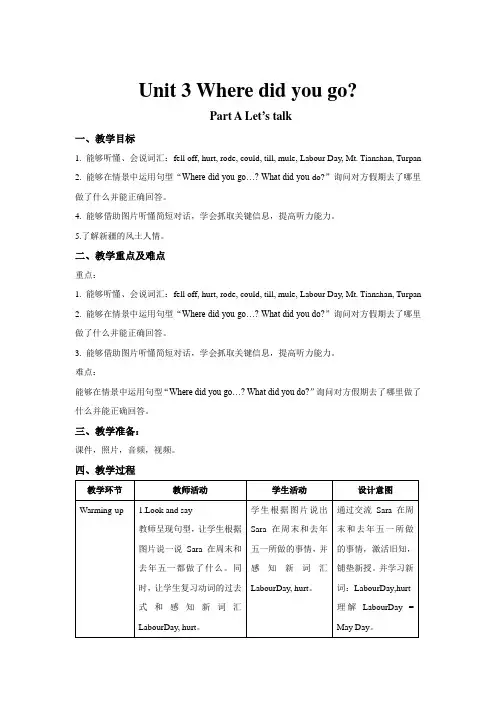
Unit 3 Where did you go?Part A Let’s talk一、教学目标1. 能够听懂、会说词汇:fell off, hurt, rode, could, till, mule, Labour Day, Mt. Tianshan, Turpan2. 能够在情景中运用句型“Where did you go…? What did you do?”询问对方假期去了哪里做了什么并能正确回答。
4. 能够借助图片听懂简短对话,学会抓取关键信息,提高听力能力。
5.了解新疆的风土人情。
二、教学重点及难点重点:1. 能够听懂、会说词汇:fell off, hurt, rode, could, till, mule, Labour Day, Mt. Tianshan, Turpan2. 能够在情景中运用句型“Where did you go…? What did you do?”询问对方假期去了哪里做了什么并能正确回答。
3. 能够借助图片听懂简短对话,学会抓取关键信息,提高听力能力。
难点:能够在情景中运用句型“Where did you go…? What did you do?”询问对方假期去了哪里做了什么并能正确回答。
三、教学准备:课件,照片,音频,视频。
四、教学过程五、板书设计Unit 3 Where did you go?Part A Let’s talkKey words:fell off, hurt, rode, could, till, mule, Labour Day, Mt. Tianshan, TurpanKey sentences:What happened?Where did you go…?What did you do?。
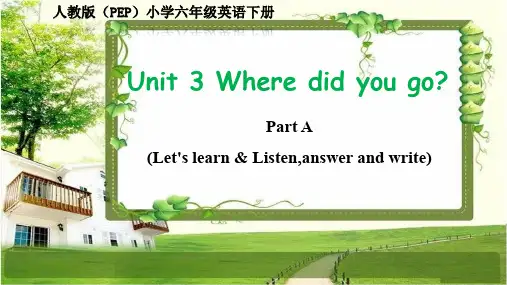
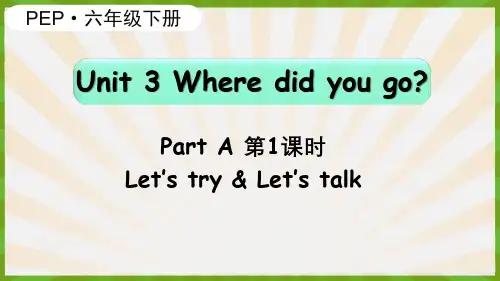
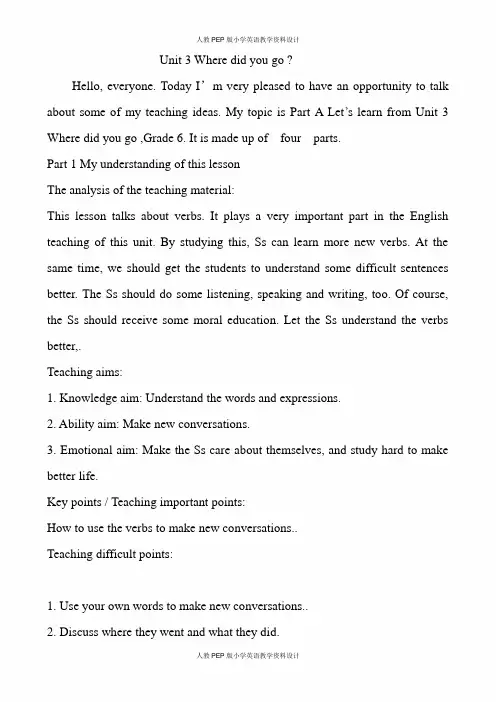
Unit 3 Where did you go ?Hello, everyone. Today I’m very pleased to have an opportunity to talk about some of my teaching ideas. My topic is Part A Let’s learn from Unit 3 Where did you go ,Grade 6. It is made up of four parts.Part 1 My understanding of this lessonThe analysis of the teaching material:This lesson talks about verbs. It plays a very important part in the English teaching of this unit. By studying this, Ss can learn more new verbs. At the same time, we should get the students to understand some difficult sentences better. The Ss should do some listening, speaking and writing, too. Of course, the Ss should receive some moral education. Let the Ss understand the verbs better,.Teaching aims:1. Knowledge aim: Understand the words and expressions.2. Ability aim: Make new conversations.3. Emotional aim: Make the Ss care about themselves, and study hard to make better life.Key points / Teaching important points:How to use the verbs to make new conversations..Teaching difficult points:1. Use your own words to make new conversations..2. Discuss where they went and what they did.Something about the Ss:1.The Ss have known something about what sb did in the past.2. They don’t often use English to express themselves and communicate with others.3. Some Ss are not active in the class because they are afraid of making mistakes.Part 2 My teaching theories, methods and aidsBefore dealing with this lesson, I’ll do my best to carry out the following theories: Make the Ss the real masters in class while the teacher himself acts as director;Combine the language structures with the language functions; Let the students receive some moral education while they are learning the English language.Teaching method:Double activities teaching methodQuestion-and-answer activity teaching methodWatch-and-listen activityFree discussion methodTeaching aids:1.some cards2.some objects3. a tape recorder4. the blackboardPart 3. Teaching steps / proceduresI have designed the following steps to train their ability of listening, speaking, reading and writing.The entire steps are:Greetings, Revision, Lead-in and reading, Preparation for details of the lesson, Consolidation, Discussion, Homework.Step 1 GreetingsGreet the whole class as usual.Step 2. Revision1. T: Act,let the Ss guess.2.Ask students some questions to revise the last lesson(show them on the screen).a. What did you do last Saturday?b. What did he do last Sunday?c. What did he do yesterday?d.What did you do last Monday?Step 3. Lead-in and preparationShow them some pictures and let them talk each other, and then use the pictures about places and the things we or they did in the past .Purpose: Arouse the students’interest of study.Bring in new subject: Where we or they went and what we or they did there. Method: Talk about the pictures , read the words and expressions and act. Purpose: Help the Ss remember the words and expressions best.Step 5. Play a game.Look, act and guess.Purpose: Make the Ss learn the expressions best and feel interesting. Step 6. ConsolidationRead the words and expressions , finish the conversation. Purpose: Let the Ss can communicate better.Step 7. DiscussionShow them some words and expressions, let the Ss talk freely. Purpose: Give the Ss much ,they can give us more.Step 8. Listening and exercise.Purpose:Improve the Ss listening and writing ability .Step 9. SummaryLet the Ss make a summary.Purpose:Let the Ss remember the lesson better.Step 10. HomeworkRead the words and expressions and make new conversations.Part 4. Blackboard designUnit 3 Where did you go?A: Where did you go_____? go went camping / fishing B: I went to ____________. ride rode a horseA:What did you do there? rode a bikeB: I ___________________. hurt hurt my footThat’s all , Thank you for listening!。
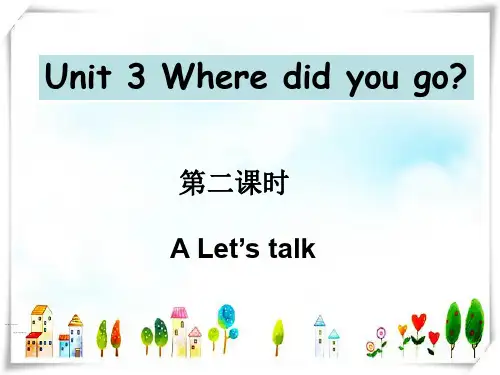
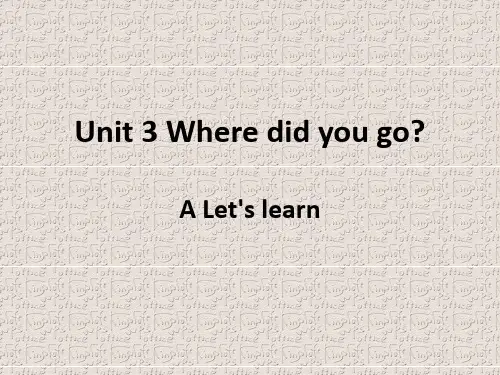
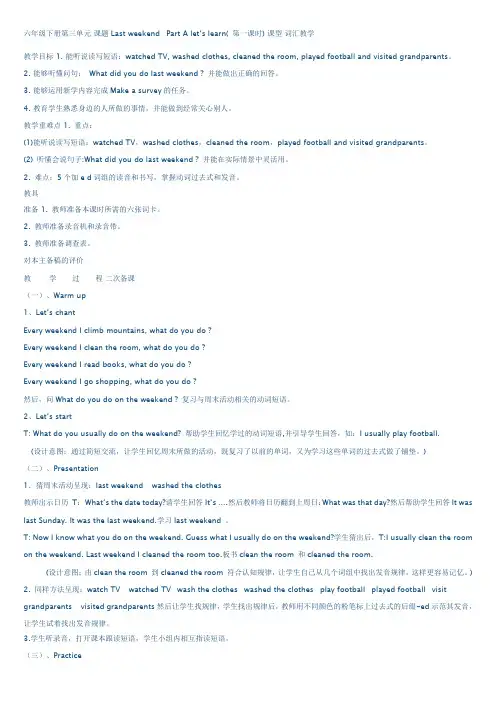
六年级下册第三单元课题 Last weekend Part A let’s learn( 第一课时) 课型词汇教学教学目标 1. 能听说读写短语:watched TV, washed clothes, cleaned the room, played football and visited grandparents。
2. 能够听懂问句:What did you do last weekend ? 并能做出正确的回答。
3. 能够运用新学内容完成Make a survey的任务。
4. 教育学生熟悉身边的人所做的事情,并能做到经常关心别人。
教学重难点 1. 重点:(1)能听说读写短语:watched TV,washed clothes,cleaned the room,played football and visited grandparents。
(2) 听懂会说句子:What did you do last weekend ? 并能在实际情景中灵活用。
2. 难点:5个加e d词组的读音和书写,掌握动词过去式和发音。
教具准备 1. 教师准备本课时所需的六张词卡。
2. 教师准备录音机和录音带。
3. 教师准备调查表。
对本主备稿的评价教学过程二次备课(一)、Warm up1、Let’s chantEvery weekend I climb mountains, what do you do ?Every weekend I clean the room, what do you do ?Every weekend I read books, what do you do ?Every weekend I go shopping, what do you do ?然后,问What do you do on the weekend ? 复习与周末活动相关的动词短语。
2、Let’s startT: What do you usually do on the weekend? 帮助学生回忆学过的动词短语,并引导学生回答,如:I usually play football.(设计意图:通过简短交流,让学生回忆周末所做的活动,既复习了以前的单词,又为学习这些单词的过去式做了铺垫。
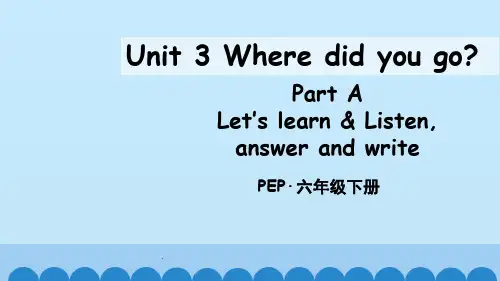
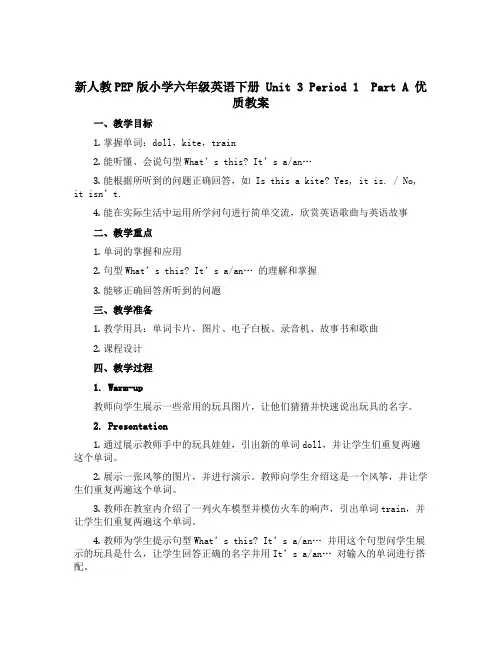
新人教PEP版小学六年级英语下册 Unit 3 Period 1 Part A 优质教案一、教学目标1.掌握单词:doll,kite,train2.能听懂、会说句型What’s this? It’s a/an…3.能根据所听到的问题正确回答,如 Is this a kite? Yes, it is. / No, it isn’t.4.能在实际生活中运用所学问句进行简单交流,欣赏英语歌曲与英语故事二、教学重点1.单词的掌握和应用2.句型What’s this? It’s a/an… 的理解和掌握3.能够正确回答所听到的问题三、教学准备1.教学用具:单词卡片,图片、电子白板、录音机、故事书和歌曲2.课程设计四、教学过程1. Warm-up教师向学生展示一些常用的玩具图片,让他们猜猜并快速说出玩具的名字。
2. Presentation1.通过展示教师手中的玩具娃娃,引出新的单词doll,并让学生们重复两遍这个单词。
2.展示一张风筝的图片,并进行演示。
教师向学生介绍这是一个风筝,并让学生们重复两遍这个单词。
3.教师在教室内介绍了一列火车模型并模仿火车的响声,引出单词train,并让学生们重复两遍这个单词。
4.教师为学生提示句型What’s this? It’s a/an… 并用这个句型问学生展示的玩具是什么,让学生回答正确的名字并用It’s a/an… 对输入的单词进行搭配。
3. Practice教师自己拿出一只玩具,用句型What’s this?来引出该玩具并让学生回答。
之后,学生分组展示自己的玩具并用同样的问句和回答进行练习。
4. Consolidation1.学生跟随教师分别说出新学的三个单词doll、kite和train,并对每个单词进行用It’s a/an… 造出简单句。
2.学生听老师读句子,并判断句子的真假。
例如:•Is this a kite? Yes, it is.•Is this a train? No, it isn’t.5. Extension1.给学生讲一个英语故事,并让学生回答故事内容的相关问题。
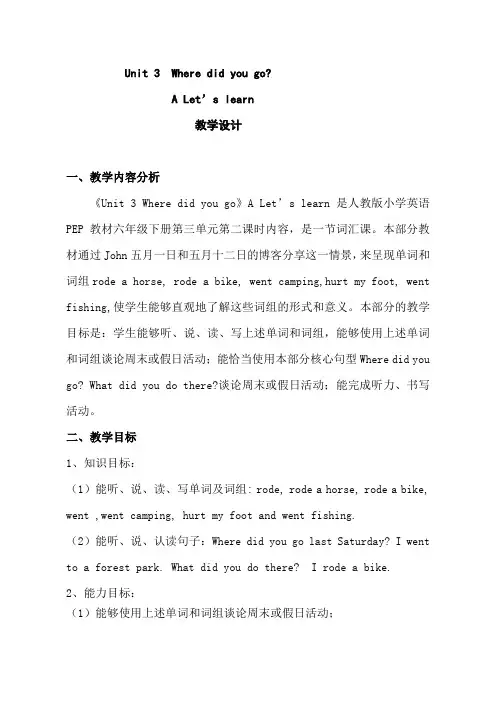
Unit 3 Where did you go?A Let’s learn教学设计一、教学内容分析《Unit 3 Where did you go》A Let’s learn是人教版小学英语PEP教材六年级下册第三单元第二课时内容,是一节词汇课。
本部分教材通过John五月一日和五月十二日的博客分享这一情景,来呈现单词和词组rode a horse, rode a bike, went camping,hurt my foot, went fishing,使学生能够直观地了解这些词组的形式和意义。
本部分的教学目标是:学生能够听、说、读、写上述单词和词组,能够使用上述单词和词组谈论周末或假日活动;能恰当使用本部分核心句型Where did you go? What did you do there?谈论周末或假日活动;能完成听力、书写活动。
二、教学目标1、知识目标:(1)能听、说、读、写单词及词组: rode, rode a horse, rode a bike, went ,went camping, hurt my foot and went fishing.(2)能听、说、认读句子:Where did you go last Saturday? I went to a forest park. What did you do there? I rode a bike.2、能力目标:(1)能够使用上述单词和词组谈论周末或假日活动;(2)能够使用核心句型:Where did you go ...? What did you do? 谈论周末或假日活动。
(3)能完成听力、书写活动。
3、情感目标:培养学生合理安排学习和生活的能力,激发学生热爱大自然的美好情感。
4、学习策略:通过小组合作的学习方式培养和提高学生的合作意识,提高学生的学习能力。
5、文化意识:激发学生热爱大自然的美好情感并进行外出游玩的安全教育。
Unit 3 Where did you go ?
Hello, everyone. Today I’m very pleased to have an opportunity to talk about some of my teaching ideas. My topic is Part A Let’s learn from Unit 3 Where did you go ,Grade 6. It is made up of four parts.
Part 1 My understanding of this lesson
The analysis of the teaching material:
This lesson talks about verbs. It plays a very important part in the English teaching of this unit. By studying this, Ss can learn more new verbs. At the same time, we should get the students to understand some difficult sentences better. The Ss should do some listening, speaking and writing, too. Of course, the Ss should receive some moral education. Let the Ss understand the verbs better,.
Teaching aims:
1. Knowledge aim: Understand the words and expressions.
2. Ability aim: Make new conversations.
3. Emotional aim: Make the Ss care about themselves, and study hard to make better life.
Key points / Teaching important points:
How to use the verbs to make new conversations..
Teaching difficult points:
1. Use your own words to make new conversations..
2. Discuss where they went and what they did.
Something about the Ss:
1.The Ss have known something about what sb did in the past.
2. They don’t often use English to express themselves and communicate with others.
3. Some Ss are not active in the class because they are afraid of making
mistakes.
Part 2 My teaching theories, methods and aids
Before dealing with this lesson, I’ll do my best to carry out the following theories: Make the Ss the real masters in class while the teacher himself acts as director; Combine the language structures with the language functions; Let the students receive some moral education while they are learning the English language.
Teaching method:
Double activities teaching method
Question-and-answer activity teaching method
Watch-and-listen activity
Free discussion method
Teaching aids:
1.some cards
2.some objects
3. a tape recorder
4. the blackboard
Part 3. Teaching steps / procedures
I have designed the following steps to train their ability of listening, speaking, reading and writing.
The entire steps are:
Greetings, Revision, Lead-in and reading, Preparation for details of the lesson, Consolidation, Discussion, Homework.
Step 1 Greetings
Greet the whole class as usual.
Step 2. Revision
1. T: Act,let the Ss guess.
2.Ask students some questions to revise the last lesson(show them on the screen).
a. What did you do last Saturday?
b. What did he do last Sunday?
c. What did he do yesterday?
d.What did you do last Monday?
Step 3. Lead-in and preparation
Show them some pictures and let them talk each other, and then use the pictures about places and the things we or they did in the past . Purpose: Arouse the students’ interest of study.
Bring in new subject: Where we or they went and what we or they did there. Method: Talk about the pictures , read the words and expressions and act. Purpose: Help the Ss remember the words and expressions best.
Step 5. Play a game.
Look, act and guess.
Purpose: Make the Ss learn the expressions best and feel interesting. Step 6. Consolidation
Read the words and expressions , finish the conversation.
Purpose: Let the Ss can communicate better.
Step 7. Discussion
Show them some words and expressions, let the Ss talk freely. Purpose: Give the Ss much ,they can give us more.
Step 8. Listening and exercise.
Purpose:Improve the Ss listening and writing ability .
Step 9. Summary
Let the Ss make a summary.
Purpose:Let the Ss remember the lesson better.
Step 10. Homework
Read the words and expressions and make new conversations.
Part 4. Blackboard design
Unit 3 Where did you go?
A: Where did you go_____? go went camping / fishing
B: I went to ____________. ride rode a horse A:What did you do there? rode a bike
B: I ___________________. hurt hurt my foot
That’s all , Thank you for listening!。